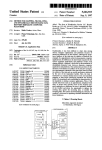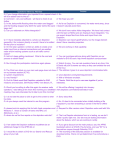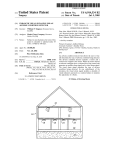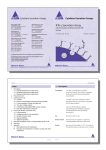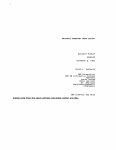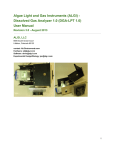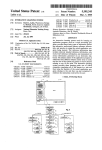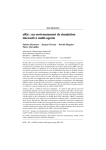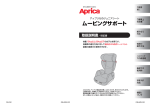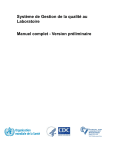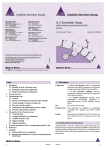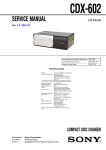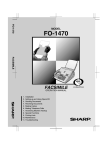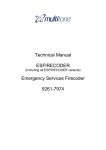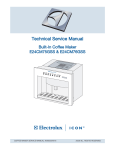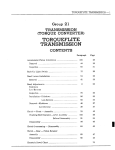Download Word based text producing system
Transcript
USOO5649223A United States Patent [191 [11] Patent Number: Freeman [45] Date of Patent: [76] Inventor: Alfred B. Freeman, 420 Tibbetts Hill Rd., Go?’stown, NH. 03045 “The Point of the Pen”, by Robert M. Carr Byte, Feb. 1991, pp. 211-221. [21] Appl. No.: 808,843 Dec. 17, 1991 [22] Filed: ‘Touch-and-Feel Interfaces”, by Andrew Reinhardt Byte, Feb. 1919, pp.’ 223-226. Related US. Application Data Primary Examiner-Jeffery Hofsass Assistant Examiner-Andrew Hill [63] Continuation-impart of Ser. No. 440,994, Nov. 22, 1989, abandoned, which is a continuation-impart of Ser. No. 392,727, Aug. 11, 1989, abandoned, and Ser. No. 288,011, Dec. 21, 1988, abandoned. [57] 1m. 01.6 ...................................................... .. G06F 3/14 words and attributes in locations which associate them with US. Cl. ............................ .. 395/796; 341/20; 341/22; input actions. Possible attributes include letters, phonetic sounds, character strokes or parameters as appropriate for the language. Attributes inputted select word sets from a vocabulary which has N sets of a plurality of word sets in Field of Search ............................... .. 364/419, 419.1, 364/419.14, 419.15, 419.17, 709.01, 709.11, 709.12, 709.16; 400/110. 421, 98, 420; 341/20, 21, 22, 23, 35; 345/145, 146, 168, which the words of each set share a unique set of one to N attributes. The display presents accessed word sets which the user may search for wanted words. Vocabulary words 179, 184 include codes to select in?ection sets when they are selected. References Cited [56] ABSTRACT On word starts, the system displays sets of very frequent 341/23; 400/98 [58] Jul. 15, 1997 “Multilingual Word Processing”, by Joseph D. Becker Scienti?c American, Jul. 1984, pp. 96-107. [54] WORD BASED TEXT PRODUCING SYSTEM [5 1] [52] 5,649,223 For alphabetic languages, spelling rules and a store of U.S. PATENT DOCUIVIENTS 3,379,722 4/ 1975 4,242,676 12/1980 4,333,097 6/1982 4,365,235 12/1982 4,374,625 2/1983 4,383,307 5/1983 modi?ed word ends and in?ection starts are used in the application of in?ections. Selected words, with or without Knowlton .............................. .. 340/711 Piquet et al. .. Buric et al. in?ections, are outputted by input actions which may append ‘Space’ or punctuation endings. User actions on keyboard and/or stroke sensing apparatus input attributes and select, in?ect, and output words with endings. Some keyboard apparatus responds to key combinations and others to single 341/23 . . ... .. . . . .. 340/711 Greanias et al. .. .. 340/146.3 Hanft et al. . . . . . .. .. . .. .. 400/98 Gibson, 111 ........................... .. 364/900 (List continued on next page.) keys. Stroke apparatus senses motion of a pen in each of a FOREIGN PATENT DOCUMENTS plurality of directions and patterns and inputs data items associated with the respective motions by the positions of 0672988 9/1995 the displayed items with respect to a reference location. European Pat. OE. ...... .. G08F 17/27 OTHER PUBLICATIONS 20 Claims, 10 Drawing Sheets ‘Typewriter Keyboard Addition Based on Word Concept” by Chang, I. F., Nov. 1979 vol. 22, No. 6, IBM Technical Micro?che Appendix Included (2 Micro?che, 107 Pages) Disclosure Bulletin. I40 /3.0 CHORD - PROCESSOR / OTHER 2 26 psugR ‘4+ QUEUE u SELECT /46 SWITCHER B I60 OUTPUT 3’38 4° / INFLECTIONS MEMBER ~37 — 45 SELECTOR INPUT SET PROCESSOR SELECTOR l [l6b 4| / 220 PUT _L, D'SPLAY "' DISPLAY "'36 ‘/4 2 SET VOCABULARY v \ 44 l 22b 5,649,223 Page 2 Us, PATEN’I‘ DOCUMENTS $238’??? 1213:; ’ ’ 4,391,786 1/1990 Goldwasser ........................... .. 364/419 4,893,238 1/1990 Venema .... .. 364/419 4,969,097 11/1990 Levin .... .. . 364/419.15 .... .. 364/419 4,459,049 7/1984 5,119,296 6/1992 Zheng et a1. 7/1984 5,151,950 9/1992 Hullender ..... .. 382/13 4,464,070 8/1984 5,187,480 2/1993 Thomas et a1. . 341/22 H1986 5,214,428 4/1993 5/1993 Riskin Allen ..... ....... .. .. 4,594,686 6/1986 4,783,761 11/1988 4462 703 4,760,523 7/1968 4,775,956 10/1988 4,868,750 9/1989 Kucera .................................. .. 364/419 5,229,936 5,367,453 5,442,547 5,479,333 .... 341/20 7/1993 Decker et a1. ................. .. 364/419 11/1994 Capps et a1. ............. .. 364/419.13 8/1995 Kutsumi et a1. . 364/419.08 12/1995 TSImeyOShi ............................. .. 364/14 - US. Patent [email protected]!1<oEI Jul. 15, 1997 22“aVba53E22xns3222E.3.;550mm6.m . mm5mmEu,5?58mx”?.qmmm5 mmhm32:mm5 Sheet 5 0f 10 52:3mmx”;5mmvm36v51. mm5$9:mmkm4 to,mmi?3vmvs?mm5 mmEm@mm52 5mmVF?wwvmmm1%.6 mmEm955mm5mmVF;wwwmmmii5 mmwm. 5,649,223 .oEw US. Patent Jul. 15, 1997 E5om.zQw0hqom:xE<cwzIm as?“=32.“.33E22$V9.3E.5a;2n:s uumwow‘ 6N08gVF?6?:5?3noNo6 5. m Sheet 6 of 10 68muX”?g3E;3Va?8No6 no*02¢u2 6muvat»#2mu6. N0833EnoNo61m?x”?6 5muno32:358No6 V5V?3? 5,649,223 .oE\. US. Patent 8T0 8ST\ Jul. 15, 1997 1ST\ accw 10w > ' Sheet 9 of 10 5,649,223 ITO 2ST /2TO STi scw 7ccw 7ST—~ 7T‘ - 3T0 7T0 "3ST 6ST /4ST 6T0 4T0 5T0 5ST FIG. 11 25 I_ ______________Z ____ __ I i 1 L _I I ELEMENT / 70 _ SAMPLE ‘ 1 26 SENSOR -> ANALYZER,- ‘ OUTPUT / |' 7| / 72 | 5,649,223 2 1 WORD BASED TEXT PRODUCING SYSTEM ONE HAND CHORD TYPING: This application is a continuation-in-part of now aban words and characters from chords determined by detection of First Released Keys or All Released Keys. Eilam et. al., U.S. Pat. No. 4,833,446, En?eld, U.S. Pat. No. 4,442,506, Densen, U.S. Pat. No. 4,836,700, are other Bequaert et. al., U.S. Pat. No. 4,042,777, produces both doned U.S. patent application Ser. No. 07/440,994 ?led Nov. 22, 1989 which is a continuation-in-part of now abandoned US. patent applications Ser. No. 07/392,727 ?led Aug. 11, examples of one handed typing systems. 1989 and Ser. No. 07/288,011 ?led Dec. 21, 1988, now abandoned, the parents being included herein by reference. MICROFICHE APPENDIX 10 TELEPHONE KEYBOARD ALPHABEI‘IC CHARAC TER TYPING: Hilborne et. al., U.S. Pat. No. 3,833,765, Knowlton, U.S. Pat. No. 3,967,273, Prame, U.S. Pat. No. 4,344,069, and The Micro?che Appendix, comprising 2 micro?che with Whitaker, U.S. Pat. No. 4,490,056 produce character outputs a total of 107 frames, lists C source code and assembly from sequential operations of more than one key. TINHNG OF KEY OPERATIONS FOR CHORDS: Rollhaus et. al., U.S. Pat. Nos. 4,638,306 & 4,674,280, and Goldwasser, U.S. Pat No. 4,891,786, use the time intervals between operations of key combinations to distin language sections for programs to implement embodiments of the invention discribed herein. BACKGROUND OF THE INVENTION guish chords. ABBREVIATED TYPlNG OF WORDS: Arellano et. al. “Word Generation System for Typists”, 1. Field of the Invention The present invention is directed generally to improve ments in systems to input text to applications with comput ers and the like and particularly to systems which require less input data than that contained in the words themselves. The invention systems include embodiments responsive to inputs from keyboards and others to inputs from non keyboard apparatus such as pens, touch sensative screens, mice, etc. Some keyboard embodiments use both key actua tion and key release inputs and others only inputs from key 20 25 actuations as represented either by scan codes or character codes. Non-keyboard inputs can be handwritten characters, positions touched, and strokes of force, motion. or position. 30 IBM Technical Disclosure Bulletin, Vol 17, No. 8, January 1975, describes a system which generates the ?nal portions of words after the typing of strings of ?rst letters. Todd, “Abbreviated Typing for Word Processing”, IBM Technical Disclosure Bulletin, Vol. 21, No. 9, February 1979, generates words in response to the typing of abbre viations of the words. Venema, U.S. Pat. No. 4,893,238, Levin, U.S. Pat. No. 4,760,528, Howell et al., U.S. Pat. No. 4,459,049, and Goldwasser, U.S. Pat. No. 4,891,7 86, also use abbreviations to type words. DISPLAYS OF KEYBOARD FUNCTIONS: Knowlton, U.S. Pat. No. 3,879,722, provides an optical 2. Discussion of the Prior Art means to impose images from a CRT screen to a keyboard The following includes art cited by the Patent O?ice in actions on the parent applications and art previously dis cussed in the parents. It is included as background although Buric et. a1, U.S. Pat. No. 4,333,097, in a system using multiple sets of functions for keys, responds to key opera tions with a display of the resulting new set of key functions much is not pertinent to the present case. on a keyboard map. CHORD TYPING SYSTEMS: Eibner, U.S. Pat. No. 4,425,627, displays functions responsive to function key operations. Stenograph systems registered combinations of key actua tions on a paper tape and advanced the tape when all keys had been released. Typewriter systems used shift keys to Pick, U.S. Pat. No. 4,185,282, displays a keyboard map of change the characters outputted by other keys operated at the key assignments for different languages. Goldwasser, U.S. Pat. No. 4,891,786, displays words same time. The subsequent art is replete with systems using chords, or key combinations, of various types to improve the associated with keys on a keyboard map. The set of words typing of text in one way or another. Some examples of words available from the next stroke. WORD & SUFFIX TYPING: different types of chording systems for text typing follow: MECHANICAL TYPEWRITER WORD TYPING: Bullock, U.S. Pat. No. 1,275,657, added keys to a type writer to type words. Seiber, U.S. Pat. No. 2,717,686, added a special shift key so other keys typed words when operated with it. displayed changes in response to key operations to show the 45 Chang, IBM Technical Disclosure Bulletin, Vol. 22, No. 6, Nov. 1979 teaches the typing of words from standard keys and the space bar. 50 Schaefer, U.S. Pat. No. 3,289,804, typed words with keys depressed beyond their normal range. Hanft et. a1. U.S. Pat. Nos. 4,374,625 & 4,464,070, type su?ixes from keys with the suf?xes depending upon the S'IENOGRAPHIC KEYBOARD WORD/TEXT TYPING: Balston, U.S. Pat. No. 1,590,998, suggests, but does not preceding string of characters typed. implement, the selection of a set of words with one key followed by the selection of a word from the set with another key. The word sets include sets of words with a particular suffix or in?ected form. Baisch, U.S. Pat. No. 3,558,820, attempts a system for producing text from stenographic type inputs with an enlarged keyboard that includes keys added for words, pre?xes and suffixes. Ayres. U.S. Pat. No. 3,225,883, Wright, U.S. Pat No. 3,557,927, Binenbaum, U.S. Pat. No. 3,597,538, Budworth et. al., U.S. Pat. No. 3,892,915, and Le?er, U.S. Pat. No. 4,765,764, are examples of systems that produce text from stenographic inputs. Hayashi et. al., U.S. Pat. No. 4,396,992, type words from keys preceded by the space bar and sui’?xes from keys preceded by letters, all if followed by a special key. Goldwasser, U.S. Pat. No. 4,891,786, uses the 7’ key in combination with other keys to type su?ixes appended with spelling changes when necessary. IDEOGRAPHIC TYPING: Tzu-Hung Li, U.S. Pat. No. 3,950,734, divides Chinese characters into a pre?x and a su?ix related to one of 10 primary character elements. The 10 pre?xes and the 10 su?ixes are further divided into 100 divisions. A 100 key keyboard then provides for typing pre?x and su?ix combi nations in two strokes to specify the Chinese characters. 65 Wang Young-Min, U.S. Pat. No. 4,684,926, arranges selected roots on 25 keys of a standard keyboard to obtain Chinese characters. 5,649,223 3 4 Andrew Chui, U.S. Pat. No. 4,689,743, encodes Chinese characters by basic stroke elements and sequences and then orders characters having the same codes by the degree of stems, each with text data and, in the case of in?ected languages, also with data for in?ected forms. The word stems of each set share one or more attributes whose inputs complexity. select the set. Single attributes get the most frequently used word sets, more attributes get successively less frequent sets. OTHER SYSTEMS: The article, “Multilingual Word Processing”, Joseph. D. Becker, in the Scienti?c American of July 1984, discusses some of the difficulties inherent in typing the large number of characters of ideographic languages and describes a phonetic conversion system presently in use to type Japa Possible attributes include elements or characters that apply, or are part of, all set members. The attributes used for word sets depend on the language and on potential users. In the case of alphabetic languages, starting letter strings of 10 nese. In this system, the user types words in a phonetic alphabet to computer apparatus which searches a dictionary to ?nd the words having the input sound strings. The sound wanted words are known by writers so various lengths of letters strings serve nicely as sets of attributes. Inputs of strings of letters with no set assigned can produce words not in the system vocabulary. Any language could substitute strings are frequently matched by more than one word and the user then makes additional inputs to select the word wanted from those matched. phonetic sounds for letters as attributes. Non-alphabetic Most of the foregoing systems combine chord typing with regular typing. Goldwasser and Rollhaus et. al., for example, use the time intervals between key operations to distinguish those for chords from those for regular typing. Arellano et. a1. Todd. Chang, Hayashi et. al., Venema, and Goldwasser, use dedicated strings or special keys to mark inputs for words. language lmow and easily associate with words. Some languages may ?nd parts of speech useful as additional languages may supplement or replace phonetic sounds with components or parameters of text characters that users of the Byte, published by McGraw Hill, articles titled "Ihe Point of the Pen” and ‘Touch and Feel Interfaces”, pgs 221-226, of the February 1991 issue and “NCR Knows 25 Notepads”, gs 37-38, of the August 1991 issue discuss Pen and other non-keyboard input systems. typists. For stroke inputs, the display presents the words and SUIVHMARY OF THE lNVENTION attributes positioned about a center. Directions ?om the center correspond to those of stroke directions for selection. Each selection advances the display to the next set to The overall objective of the present invention is a better way to produce the text of any language for any computer type application responsive to inputs from keyboards or from non-keyboard apparatus. continue its guidance. 35 An objective of the present invention are systems which enable display assisted users to produce nearly all of the words of any language with a minimum amount of input information. Another objective of the present invention are systems of the aforementioned type which literate persons can almost immediately use to produce text. Still another objective of the present invention are sys tems of the aforementioned type which use keyboard inputs and which enable typists to type easier and faster. Yet another objective of the present invention are systems of the aforementioned type which use keyboard inputs and attributes. All languages include a set of words whose only shared attribute is very frequent use. On word starts, a display shows a set of the most frequently used words and indicates the inputs to select the words. The inputs may also select attributes which in turn select the next most frequent word sets. For position inputs, the display has the items spread out for easy touch selection. In the case of keyboard models, the display shows the words mapped on a keyboard to associate with the keys which select them. The display may include key characters to assist Users should quickly learn the inputs for the most fre quent words and ?rst set attributes to save time in looking at the display. They can then dispense with the display for word starts. Few users will learn the inputs for all of the words of a language, however, and the display will continue to be necessary for sets of less frequent words. Users will also learn the set of in?ections and endings and so might also dispense with their display. The reduction of word writing system display requirements after learning may be important for some applications. The display makes the present inven 45 tion system practical for learning and for large numbers of Words. The general logic of the present invention systems has the ?rst input selecting a word and an attribute which in turn which enable very high typing speeds. selects a ?rst set of words. The second input may output the Afurther objective of the present invention are systems of selected word; may apply an in?ection or ending to the the aforementioned type which use non-keyboard inputs and selected word; or may select both a word from the ?rst set which enable rapid and easy input of text by persons without and a second attribute. The combination of the second keyboard skills. attribute and the ?rst attribute inputted selects a next set of A further objective still of the present invention is a pen words. Output of selected words, with or without in?ections system for rapid and easy input of text and/or other data for 55 and/or endings added, sets up new word starts. Successive any application. inputs for wanted Words continue to select new words and sets as long as the vocabulary has sets assigned to the string Still further objectives of the instant invention will become apparent from the following description and claims. Present invention system user inputs guided by displays select sets of word stems, select word stems from selected sets, apply in?ections to selected word stems, and append endings to selected word stems to produce word text. The word stems come from a system vocabulary responsive either to inputs from keyboards or non-keyboard apparatus. of attributes inputted. (In the case of alphabetic languages, when there are'no sets, the system outputs the string of letter attributes inputted.) Embodiments, herein referred to as chord models, have keyboards which signal key actuations and releases use ?rst key actuations to select words and sets. Release of ?rst keys before actuation of other keys outputs the selected words. Actuation and release of other hand keys before ?rst key System vocabularies can cover a language for text docu ments or cover only a small set of words for particular release selects members of selected sets. The selection of a applications. Language vocabularies hold sets of word member enables other hand keys for stem in?ections. Actua 5,649,223 5 6 tion and release of keys in order with typing overlaps select keyboard users and offer a common interface to word successive words and attributes to select successive sets. Satellite key features use two keys operated at the same time writing, word processors, operating systems, and other pro grams. Stroke input systems offer advantages for applica by either hand to select more sets or in?ections. Each hand tions other than word writing. can operate two keys to single chord type many words. Embodiments, herein referred to as actuate only models. DESCRIPTION OF THE DRAWINGS The aforegoing and other objects. features, and advan tages of the invention will be apparent from the following descriptions of preferred embodiments of the invention illustrated in the accompanying drawings. use either key actuation or character signals as inputs. The inputs select pairs of items as do the ?rst keys on chord models. The pair on word starts are MFWs and ?rst key sets as on chord models. Next letter key actuations get a letter and either a word or an in?ection to apply to the previously FIG. 1 is a functional block diagram of embodiments of the present invention system. selected word. Space Bar operation outputs the selected FIG. 2 is a more detailed functional block diagram of the word, MFWs or other, with any in?ections applied, and adds a ‘Space’. Punctuation key operations also output the selected word and append a Punctuation String. The ‘Tab’ key enables the selected word to be compounded with the next word or a regularly typed su?ix. The ‘Enter’ key 15 word producing system block of FIG. 1. FIGS. 3A and 3B show arrays for English language modi?cations to word stem endings and in?ections. FIG. 4 is a diagram of a word set packet for a set enables the letter string to be a pre?x or a word. vocabulary. Pen input systems with recognition of handwritten char acters could replace key actuate or character inputs to actuate only models. The present invention systems include as an alternative a stroke input system for word writing and other applications. The strokes of this system consist of FIG. 5 is a partial block diagram of an arrangement of word set packets in a set vocabulary. FIG. 6 shows the patterns of Satellite Keys for sequential operations that relate to Reference Keys in the different row motion, or force, patterns that are much easier for users to execute and programs to recognize than handwriting. Dis play of stroke assignments about a reference associate them positions. 25 with stroke directions. Stroke inputs can more or less FIG. 8 shows a set of 24 strokes from a common center for a pen or other motion I force device. directly replace key inputs and pen lifts the Space Bar in actuate only models. Pen lifts allow relocation after mean dering movements for successive strokes and further allows the use of starting positions as inputs to an executive set. 30 FIG. 10 shows an arrangement of locations for display of items assigned to 32 strokes of FIG. 9 and FIG. 10. FIG. 11 shows a set of 24 long strokes with eight targets typing compatibility considerations. The starting position on a rectangular grid and eight more targets for a set of 24 short strokes. FIG. 12 shows an arrangement of locations for display of executive set provides quick access to more than one word start set and/or to special vocabularies. Other hand key operations can combine with strokes in hybrd chords or items assigned to the 48 possible strokes of FIG. 12. select alternate assignment sets. Keys could select endings FIG. 13 is a functional block diagram of a stroke input for stroke or touch selected words. Joysticks and any other system. means to sense motion or force of ?ngers or thumb can DESCRIPTION OF THE PREFERRED provide stroke inputs instead of pens. The present word writing system is perhaps the most 45 skilled in the art will recognize that the present stroke input system has other applications in which it is an improvement over prior means for making inputs related to displayed items. In many prior applications, users select displayed invention system embodiments. Keyboard 11, which may key release code signal outputs. The key signals go to hardware speci?c interface 12. Keyboard 11, interface 12, and user keyboard interface 17 may be part of a host computer. Interface 12 normally passes the key signals along on line 13 to interface 17 which translates them to character signals. Interface 17 then supplies the character signals to host computer user systems 18 in response to requests for 55 keyboard services. ' The present invention word writing system minimizes the As modi?ed for some embodiments of the present inven tion systems, interface 12 supplies the key signals on line 14a to word producing system 15. Interface 17 receives key inputs required for text production and guides beginners and other users to inputs for any wanted word in a language. The system can include and similarly get words from smaller vocabularies of technical or custom terms for particular or character signals on line 16a from system 15. In other embodiments, interface 17 outputs translated character sig nals on line 14b to word producing system 15 which then outputs character signals on line 16b to user systems 18 in users. The system can also access words for other uses, such dictionary look up and other data bases. Touch input models are easiest where speed is not important. Chord models with the Satellite Key features o?’er maximum speed for those who develop new skills. Actuate only models mostly use existing typing skills and so are easier for typists to learn. Stroke models provide word writing functions for non EMBODIMENTS FIG. 1 is a general block diagram of modules for instant include a built-in microprocessor, produces key actuate and items by moving a mouse until the mouse pointer reaches the item and then clicking a mouse button. The present stroke input system allow the user to get the same item with a small motion. Pens can combine with auxiliary switches and even keyboards. Pens can include functions like those of a mouse, relocating displayed items, etc. FIG. 9 shows the eight straight strokes of FIG. 9 along with eight fast strokes and eigtht short strokes, all from a common center. The present invention stroke input system not only replaces the keyboard in actuate only models but also enables word writing models not limited by keyboard and demanding application for stroke input systems. Those FIG. 7 shows the patterns of Satellite Keys for operations in combination that relate to Reference Keys in the diiferent row positions. 65 answer requests for keyboard services. Word producing system 15, the main program module for the present inven tion system, in one embodiment handles key signals from keyboard 11 and the second embodiment handles key char acter signals. 5,649,223 7 8 User systems 18 consist of devices or programs which request keyboard services and use the key characters and Key signals on line 14a from keyboard 11 via interface 12 go to chord processor 30. Keyboard character signals on line 14b and other signals on line 26 from other input systems 25 other data derived from key operations by interface 17 or word producing system 15. User systems 18 supplies data go to other input processor 32. Embodiments can have either a keyboard 11 or other input systems 25 or both. Processors for display via line 19 to user display interface 20 which 30 and 32, present when their respective input signal sources are included, apply signals to set selector 36, member selector 37, and output queue 38. Chord processor 30 further produces signals to select switcher 40. passes it along to display system 21. User display interface 20 and display system 21 also normally part of the host computer. present the text and other data from user systems 18 on the computer screen. If these units have a multiple Set selector 36 uses its input signals to select sets of words from set vocabulary 42. Member selector 37 uses ?rst input signals to select words from the selected sets and successive window capability, system 15 also supplies data for display via line 22a to interface 20. Display system 21 then presents the user systems 18 data in one window and the system 15 inputs to apply in?ections and other endings to the selected words. Member selector 37 outputs the resulting text to data in another. Otherwise, auxiliary display 23 receives the system 15 data via line 22b. output queue 38. Put user 41 outputs the contents of output queue 38 via line 16a to user keyboard interface 17 or via line 16b to user systems 18. Chord processor 30 signals Other input systems 25 supplies input signals via line 26 to word producing system 15. Other input systems 25 may include various types of non-keyboard apparatus such as a select switcher 40 when succeeding inputs require changes Pen or a Mouse, a touch sensative screen, a Joystick, etc. A Pen input system with hand written character recognition or a virtual keyboard can produce outputs to substitute for 20 keyboard signals. A new stroke input system for systems 25 produces inputs for word production in response to move ment or force patterns much simpler than those letters. Touch responsive screens for displays 21 or 23 would allow ?ngers or pens to make inputs by touching displayed words 25 in previous actions. Switcher 40 in turn signals set and member selectors 36 and 37 to make the changes. Set selector 36 responds to inputs from chord processor 30 and select switcher 40 and from other input processor 32 for set selection. Selector 36 searches set vocabulary 42 to ?nd the word sets assigned to the inputs. The most frequent sets are assigned single inputs and others to strings of two or more inputs. The searches are similar to those of parent and other items. Systems 25 encompasses a range of alter natives to keyboard 11 and interfaces 12 and 17 for inputting to word producing system 15. applications except that the target items are sets of words rather than individual Words. Vocabulary 42 holds sets of Keyboard 11 signals both key actuations and releases to application vocabularies held words. The searches will be hardware speci?c interface 12 in some embodiments and described in more detail later. When set selector 36 ?nds a set, it supplies a pointer to the words assigned to inputs and input strings, much like parent only key actuations in others. Interface 12 includes the apparatus and/or software necessary to supply the key signals via line 13 to user keyboard interface 17 and/or via line 14a to word producing system 15. As previously mentioned, interface 12 will generally be a modi?ed version of the host computer hardware and software which normally handles key signals from keyboard 11. Word producing system 15 responds to inputs on line 14a with outputs on line set to member selector 37 and to display 44. Member selector 37 and display 44 use the set pointer to work with the selected set. Display 44 gets the set data for display to assist users in ?nding wanted words. Member selector 37 gets the members of selected sets called for by ?rst inputs and holds them for in?ections and endings and/or output. Put display 45 copies the text and other parts of the set from 16a to user keyboard interface 17. display 44 to display system 21 or auxiliary display 23 via User keyboard interface 17 consists of the software routines, such as those of host computer operating systems, line 22a or line 22b. If set selector 36 can ?nd no set that handle keyboard services. In the case of the IBM Personal Computer, such routines are in the system BIOS. These routines translate key scan codes, store shift status, 45 produce character code outputs, answer requests for services. etc. Interface 17 translates key signals received on line 16a, as it does those direct from keyboard 11 on line 13. If word producing system 15 outputs on line 16a are character signals, interface 17 passes them along to user 50 systems 18 as part of its keyboard services. In other embodiments, interface 17 instead outputs character signals, derived from line 13 key signals, on line 14b to system 15. Word producing system 15 responds to the inputs on lines 14a and 26 with character signal outputs on line 16b to user systems 18 to directly answer requests for input characters. The several embodiments of word producing system 15 consist of program modules which could run on a micro processor but generally run on the host computer. In the case of an IBM Personal Computer running MS DOS, word producing system 15 would be installed with the MS DOS Terminate but Stay Resident Service to be available to the 55 assigned to the inputs received, it sends a No Set signal to processors 30 and 32. The inputs to member selector 37 for members indicate the member numbers in the sets. Member selector 37 counts the members from the set start pointed to by the set pointer to ?nd the number members. The Words in the sets ends with bytes having their high bit set to facilitate word counting. The other bits of the end byte represent an sic_code that speci?es a set of in?ections and other possible endings for the word. Some words further include text codes for in?ec tions that require additional information to be properly applied. Member selector 37 stores the word text for in?ec tion and/or output and copies the in?ection and endings data to display 44. When set selector 36 selected a set, display 44 copied data for the word set display, as previously mentioned, to guide users to inputs for members. When member selector 37 selects a member, it supplies member data to display 44 and in?ections 46 for the set of in?ections and any other in?ec tions speci?ed by text codes. Put display 45 copies the data from display 44 via line 22a or line 22b to display systems other programs. Those skilled in the art will be able to 21 or auxiliary display 23. The resulting display guides the similarly install word producing system 15 on computer systems other than IBM Personal Computers. user to the inputs to obtain the in?ections and endings for 65 selected words. FIG. 2 is a more detailed functional block diagram of Member selector 37 receives second inputs for the appli cation of in?ections and word endings to the selected embodiments of the word producing system 15 of FIG. 1. 5,649,223 10 9 members from processors 30 and 32. Selector 37 responds TABLE B with calls to in?ections 46. In?ections 46 uses the in?ections and endings member data previously received along with DISPLAY FOR 'w‘ KEY AS CHORD WORD START built in data and rules to apply the in?ections selected to the word members stored by member selector 37. For English, in?ections include irregular ones which change the word spelling and others which append su?ixes with or without WAS a W e i 0 want war water way -— — — — — we week well went —— were —- —— — — —- will woman work world would spelling changes. Word endings further include punctuation strings and set up of compounding of next words. Upon release of the ‘w’ key before another actuation, processor 30 signals member selector 37 to output ‘?t/as”. Else processor 30 responds to other hand keys with signals Upon the receipt of word ending inputs, member selector 37 copies the selected word, with or without in?ections applied or endings added, to output queue 38. For the alphabetic languages, some embodiments have the words of the sets in set vocabulary 42 without the starting letter strings to which the sets are assigned. Display 44 and to member selector 37 to change from “was” to the word shown by Table B as assigned to the actuated key. In the case of the ‘0’ key, the newly selected word is “way”. Release of member selector 37 then obtain these letters from set selec tor 36. No Set signals produced by set selector 36 and non-letter inputs cause processors 30 and 32 to signal member selector 37 to transfer input strings to queue 38 and to pass subsequent inputs directly to queue 38. With the system ready for the start of a new word, such as after a word or ‘Space’ output, processors 30 and 32 signals set selector 36 to select a most frequently used word 20 TABLE C 25 (MFW) set. If the MFW Display is On, selector 36 also signals display 44 to present the MFWs, usually with the set of attributes used for other set selections. (‘The MFW Dis play is primarily for beginners and users who know the sets may turn it off.) Some MFWs include the attribues associ ated with them for selection and others do not. An example of a MFW set for English mapped to a keyboard follows in Table A. DISPLAY FOR 'wo' TWO IGEY CHORD SET WAY woman q wonder w word e wood a workshop s worry d worse z worship x worst c wore r l m n 0 wound v 30 The Table C display pattern is a mirror image of the Table B display pattern. Other right hand last set select keys get the 35 TABLE A the other hand key, the ‘0’ key, before the ‘w’ key sets up “way” as the newly selected word for output in place of “was” upon release of the ‘w’ key. Release of the ‘w’ key before the ‘0’ key, however, causes processor 30 to signal set selector 36 to get the set assigned to the letters ‘wo’. The display changes to present “WAY”, ‘O’ and the ‘W0’ set as shown in Table C. Table C pattern while other left hand last set select keys get the Table B pattern. The action for the Table C pattern is similar to that just described for Table B. Release of the ‘0’ key before actuation of another key outputs “Way”, the EXAMPLE OF MFW SET FOR ENGLISH three four ?ve six seven eight nine ten selected member of the last set. A left hand key, such as ‘r’, actuated before release of the ‘0’ key, selects a member of was as at to you I in of on is she had but for by have he he not the his that this it from and or the ‘W0’ set and a new set, such as the ‘wor’ set. Chord one two with a are processor 30 actions for satellite and other same hand keys remain to be described later. Like the word start inputs to chord processor 30, a word start input on either line 14b or line 26 select both a word MFW Displays, not shown, present the words of Table A and mayalso include the characters of the associated keys to 45 from the MFW set and an attribute which in turn selects a set of words. Processor 32, as previously mentioned, signals supplement the positional relations for typists. Keys in some embodiments may select ?rst key sets with attributes other than those of the key characters. The MFW Display may member selector 37 for the MFW and selector 36 for the set Unlike the chord embodiment and like the MFW Display, displays for the newly selected word sets can use the full width of the screen. This allows larger words sets than those for chord embodiments. Following signals on lines 14b and 26 successsively select new members and sets. Space bar include such ?rst set attributes or they may simply be presented in the User Manual. Most embodiments will only use the letters of letter keys as attributes for set selection after the ?rst sets to minimize learning for typists. Excep tions to this rule for the ?rst sets has the objective of accessing more very frequent word sets with ?rst inputs. signals on line 14b and a pen lift signals on line 26 via processor 32 and member selector 37 output selected MFWs 55 and other members. Key actuation and release models output selected MFWs upon release of word start keys before actuation of another key. Holding word start keys operated enables the other hand keys to select members from the selected set. The holding also enables adjacent same hand keys as Satellite keys with In all embodiments, successive set selection ends when set selector 36 ?nds no assigned sets for the inputted string in set vocabulary 42. Set selector 36 then produces a No Set signal to processors 30 and 32 for output of the previously letter assignments for selection of additional sets, as will characters as long as the No Set condition prevails. Key board models reset the No Set condition by operation of the Space Bar which also terminates the string with a ‘Space’. The Space Bar also outputs selected words in key actuation later be explained Table B shows a display produced for the ‘w’ key as the word start key. Table B shows the selected MFW “WAS”, and the reference key ‘W’ captalized to indicate highlighting. Satellite key letter assignments adja inputted string. Processors 30 and 32 output following input 65 or key character models. Pen models use the same pen lift cent to the ‘W’ and the set of 14 word stems assigned to the or auxiliary signal to both output selected words and the other hand keys complete the presentation. reset the No Set condition. 5,649,223 11 12 All embodiments in the present case use the same type of member end and serve as a stem in?ection code, or sic__ code. The member text data may also include one or more set selector 36 and set vocabulary 42 differing only the size of the sets. Set vocabulary 42 stores sets of Word stems, much as the vocabularies of parent cases stored single word stems and selector 36 accesses the sets, much as the parent case accessed the single word stems. The set packets 50 of FIG. 4 in the present case di?‘er from the word packets of FIG. 4 of the parent case in that they hold text and in?ection code data for each of the plurality of word stems in the set rather than for just one. Present case FIG. 4 packets further include Next Indexes for jumps to the next packet 50 in the chain and use two byte Branch Indexes for longer jumps to text codes for irregular in?ections. The text data may further include row and set end markers to assist member selector 37 in ?nding members and display 44 in presenting them in the proper patterns. As previously mentioned, stem in?ection code bytes, or sic_codes, have high bits set to distinguish themselves and to mark the ends of stems. The sic_codes designate sets of in?ections and optionally sets of related words. Members The FIG. 5 arrangement of set packets 50 for a fragmen tary section of vocabulary 42 is the same as that of FIG. 5 of the parent case. Only the contents of the packets di?’er. The search for sets in this case can thus be substantially the can additionally include text codes to specify irregular or infrequent in?ections. In?ected forms can be members of word sets but most are produced by selecting member stems and in?ections separately. The in?ection sets speci?ed can be either of two types. One includes only those for each stem which forms allowed words. The other is for types of stems and the sets may include some members not forming allowed words with all stems. Users then decide which same as that for words in the parent case. The present case in?ections to use with each stem. next branches. searches are somewhat more e?icient as the new Next Indexes avoid having to scan through text and code to the next packet 50 in a chain and the larger Branch Indexes eliminate the need for intermediate jumps to reach Next Branches. On word starts, set selector 36 uses the ?rst set select attribute inputted to access pointers to the line 51 a inputs to As previously described, the ?rst inputs of all model types 20 ?rst input, chord models use one type of input to select sets and another to select members. Non-chord models continue to select both a set and a member with each input. (The user’s choice of inputs depend on whether a member or 25 another set is wanted.) Upon chord model selection of a member, member selector 37 supplies the selected member the packets 50a which hold the ?rst sets. (As they are reached by pointer, the set packets 50a do not require code elements or Branch Indexes.) Set selector 36 copies the pointers to member selector 37 and display 44 for possible actions on the sets and also stores them for the start of searches called for by subsequent inputs. A second set select input causes selector 36 to jump via line 52 by the ‘Next Index’ to the following packet 50b. After the jump, selector 36 compares the second attribute inputted with the ‘Code Element’ of the packet 50b. If the ‘Code Element’ does not match the second attribute, selector 36 continues the search select both a member of a ?rst set and a second set. After the code data to in?ections 46. In?ections 46 in turn supplies display 44 with the data needed to present the set of 30 35 by using the packet 50b ‘Branch Index’ to jump to the packet 50b in the next branch. Selector 36 continues to jump and compare until it ?nds a packet 50b with a ‘Code Element’ that matches the second attribute or until there are no more branches. The packet 50b with a matching ‘Code Element’ holds the selected set. Set selector 36 copies the address of the packet 50b to member selector 37 and display 44 and stores it as the new set pointer. If set selector 36 instead ?nds that there are in?ections speci?ed by the member data. Non-chord models may require an additional input to trigger the same actions for currently selected members. As previously described, the diiferent types of models use word sets of diiferent sizes. The in?ections and endings set sizes correspond to the word set sizes with one exception. The stem most frequent in?ection sets for the Satellite keys of chord models, like the letter sets for Satellite key set selection. have only eight members. Chord models select members for output with one hand holding the last set select key while the other hand operates a key to select the member. The Satellite key in?ection set is both enabled and displayed while the member key is held. Release of the member key switches to an in?ections and endings End Set for all of the member hand keys. In chord models, release of the set select key after release of the member key signals member selector 37 to output the no matches before there are no more branches, perhaps as selected Word, with or without added in?ections and/or indicated by a Branch Index of 0, processor 30 discontinues further searching. Models for alphabetic languages use let endings, via output queue 38. Non-chord keyboard models signal selector 37 with Tab and Enter key inputs to set up other keys and the display for in?ection and endings sets and with the Space Bar input to output words. Non-keyboard ters as set select inputs and set selector 36 store them for output them on word ending inputs or on receipt of the next non-letter input. Processors 30 and 32 input subsequent attributes to set selector 36 for subsequent set selections. The set select actions for the subsequent attributes is much the same as that just described for second attiibutes. Selector 36 returns to the packet 50b through 50d with the last selected set to start the search for the next set assigned to the attribute string with the added attribute. Selector 36 again uses the ‘Next Index’ of the last set packet 50b or 50d to jump to the next packet 500 or 50d respectively and again looks for the ‘Code 50 models signal selector 37 with a special stroke or auxiliary input to enable other strokes and set up the display for in?ections and endings sets. Different speed strokes select in?ections and endings without the display. Pen lifting or another auxiliary input outputs words. 55 In?ections 45 stores the in?ection sets and other data necessary to display and apply in?ections to stems. Selector 37 responds to member select inputs by getting the selected member text and code data from vocabulary 42 for use by in?ections 46. In?ections 46 uses the sic_code to access an Element’ to match the next letter or other attribute. The Next Index is 0 when there are no more next packets 50 for the in?ection set and supplements the set with in?ections speci ?ed by text codes. Display 44 presents the resulting set. resulting string. When in?ections 46 receives an input via selector 37 for an The set text data of packets 50a through 50d of system vocabulary 42 includes the member text, or the remaining text if. as for alphabetic languages, the set select inputs are part of the member text. In the latter case, processors 30 or 65 32 or set selector 36 supply the starting letters. The text data in?ection, it correlates the input with the set displayed to indentify the in?ection selected. In?ections 46 then applies for each member includes one or more bytes which mark the the selected in?ection to the member text using its stored data for spelling rules and su?ix stem end combinations. FIGS. 3A and 3B show a set of arrays of modi?cations to stem ends and in?ection su?ixes. The micro?che appendix 5,649,223 13 14 includes an updated set of arrays stored by in?ections 46. As in the parent case, in?ections 46 checks for an array for the codes spell out alternate members for some stems. The alternate in?ections are placed in the upper row slots unless selected in?ection su?ix. If there is one, in?ections 46 scans the stem ends in the array for a match with the end of selected member held by member selector 37. If a match is they relate to other slots. Irregular plural and past tense found. in?ections 46 joins the in?ection su?ix to the end of the member with the spelling as indicated by the modi?ca tion. (The “*se_ion_ive” array has a large number of bridges for the “ion” and “ive” su?ixes. The “*se_ant__ent” array supplies “a”, “e”, and other bridges for the “nt”, “nee”, and “ncy” su?ixes. The “*se_ble_bly” array has the “i” bridge for “ble” and “bly”. A default rule applies “a” before in?ections, for example, better relate to the “s” and “ed” su?ixes and so replace them. TABLE G DEFAULT SET OF FREQUENTLY USED INFLECI‘IONS 10 “ble” or “bly” for stem ends not in the array.) ness est er ble s ed ing 1y Table H shows most of the alternate in?ections in groups If the selected in?ection su?ix does not have an array or if or the stem end is not in the suf?x array, in?ections 46 uses according to the type of stem. Some adjectives replace ‘ness’ with ‘ce’, ‘cy’, or ‘ity’. Many nouns have a “To Adjective” spelling rules of Table E to join selected members and in?ection sui?xes. have other single in?ections. Many verbs have ‘To Noun” in?ection and its cascade with ‘1y’, a have two, and some and/or “To Adjective” in?ections. Irregular verbs replace ‘ed’ with irregular past tenses and some have irregular past TABLE E 20 participles for an upper row slot. SPELLING RULES FOR APPENDING SUFFIXES TABLE H: DEFAULT REPLACEMENT INFLECI'ION SE'I‘ MEMBERS If the selected su?ix starts with a consonant, append it to the member text. Else if the selected su?x starts with a vowel the member ends as follows: If a Final 'e'; 25 Noun To Adverb: ally ically, fully, lessly, ously. Drop the 'e'. If a Final 'y' preceded by a consonant; Change the 'y' to ‘i‘. Exceptions: If 'ing' is the su?ix, no change. If 'ous' is the su?ix, Adjective To Noun: ce, cy, ity, ness. Adjective to Verb: ate, ize. Noun To Adjective: a1, ical, ful, less, ous. 30 change 'y' to 'e'. If a ?nal consonant preceded by a single vowel preceded by a consonant, Noun To Noun: age, dom, ess, hood, ic, ism, ist, ship. Verb To Noun: ion, merit, nice, ncy, er/or. Verb To Adjective: ive, nt, ble. Few English stems require more than eight slots G for their particular sets of in?ections mostly from Tables G and H. All stems together, however, use all of the in?ections of Tables G and H plus a few more. These more than ?ll the slots of a full keyboard or a 24 stroke Pen system. Like the Double the ?nal consonant. The arrays and the Spelling Rules of Table E provide for the proper appending of most in?ected fonns. Others with unusual or variant spelling are speci?ed by text codes. A text code with a stem can specify any spelling. Table F shows eight slot Satellite key sets, at least some of the other key and stroke set slots will have to handle di?ierent in?ections at different times. In some instances, the shift keys could expand the number of slots for the in?ection and ending sets. In chord models, member key release sets up the half keyboard End Set of Table I. The Table I End Set includes the eight Satellite key slots on four keys of each of the home and upper rows. The remaining keys of the Home and Upper rows and the keys of the digit row are ?lled in with other in?ections. The lower row has three punctuation strings, a some examples of text codes used in one embodiment “CNCL” function and a “CPD” function. 35 Exception: Multi-syllable member with accent not on last syllable. Note: As indicated by SIC with Non-Doubling bit set. An accent indicator would be a possible alternative. Leading digits greater than 4 relate to member slots to be occupied by the following text code units. Digits equal or TABLE I less than 4 preceding each text code letter string indicate the number of backspaces into the member end for start of the letter string. Text codes are e?icient for supplementing END SET standard sets with infrequent in?ections and for spelling exceptions. a1 ic ion ive ness est er ble ity or s ed mg 1y POSS CNCL CPD. ,_STR. ._STR. ?_STR. TABLE F TEXT CODE EXAMPLES 1891my1me go952went0ne long73ength (For "I", "my", and “me".) (For "go", "went", and "gone".) (For "long" and "length".) As previously mentioned the stem in?ection sets for chord model Satellite keys have eight members. Table G shows a default set of eight in?ection su?ixes which su?ice for large numbers of word stems. Alternating other in?ections for one 55 The punctuation strings include the number of ‘Space’ characters that usually follow punctuation marks in sen tences. Sentence ending punctuation strings further include a special character to automatically capitalize the next sentence start. Selection of a punctuation string signals member selector 37 to output the member followed by the punctuation string. The “Cpd” function eliminates the “Space” after a word to set up compounding Whatever follows with the word. The “ pd” function may also enable a set of words that frequently compouned to others, such as or more members of the default set gets sets for most of the 65 “man”, “time”, “thing”, etc. When mistakes are made, the other stems. The sic__codes include the necessary data to specify the alternate members for types of stems and text “Cncl” key can cancel the last member selected and any in?ections added. 5,649,223 15 16 As the End Set does not include all of the punctuation, models have to include other means for other punctuation and non-text characters. Chord models have the Space Bar held to enable input of these other characters. Other special letters similarly frequently follow vowel letters in vowel consonant combinations. Di?’erent vowel keys might have different sets of consonant letters for more optimum com binations at the cose of more learning. inputs set up the same sets for other models. As users have to shift concentration from word text to punctuation to select TABLE H strings from the End Set, some may prefer to use the alternate means for all punctuation. End Set punctuation SECOND KEY LEI‘IER ASSIGNMENTS strings might be handled exculsively by the alternate means S1 S2 S3 S4 S5 S6 S7 S8 and the slots used for additional in?ections. Chord models include Satellite key shortcuts to extend and speed up both set and in?ection selection. Actuation of ?rst keys by either or both hand enables adjacent keys as a l e m o n i t u p r r l s y v The set select side of the screen of Table B shows ‘w’ Satellite keys. With ?rst keys selecting sets, the Satellite keys input additional attributes to get more sets. With ?rst 15 keys selecting members, the Satellite keys input in?ections lables. Processor 30 supplies the letters and other data necessary to display the letters in the proper positions to selector 36. Selector 36 in turn copies the data to display 44 for the selected member. The Satellite keys enable skilled users to input as much with single chords as with two, or even four, individual strokes. Some models require ?rst and Satellite keys oprations in sequence. Others respond to any sequence. Sequential operation is necessary for display guidance while learning and for stems with unknown in?ec for relay via fetch display 45. As previously mentioned, 20 Satellite Keys to obtain two-letter sets with one-hand opera tions. When the Table H assignments are known, the user FIG. 6 shows the patterns of Satellite and Reference keys 25 designations are the ?ngers which normally cover the posi tions in touch typing. S1 through S8 indicate the respective Satellite keys which get the same assignments from all rows. in?ections and the various substitutions. The member select in?ections from Table G. Except for Reference keys in the index ?nger positions, the ?ngers can cover the same keys as in regular touch typing. The middle ?nger takes the Display 44 presents the in?ection text with respect to the member select key in the patterns of FIG. 6. As for set Reference key in the index ?nger position and covers the index ?nger position when the Reference key is in the index FIG. 7, like FIG. 6, shows patterns of Satellite and Reference Keys. The ‘C1’ through ‘C8’ designations of FIG. 7 indicate combination independent of the order of opera tion. The key combinations have to be unique and have the same assignments as the S1 through S8 sequential pairs of FIG. 6. The ‘C5’ through ‘C8’ labels apply to combinations can operate ?rst keys and Satellite Keys together rapidly. For in?ection selection, the ‘S1’ through ‘S8’ assignments are simply the eight slots of Table C with the most frequent ing key becomes the Reference Key and the Satellite Keys have the in?ections for the eight slots of Table C assigned. The assignments are either attributes from Table H or each position. when if a Satellite Key is actuated with a First Key, switcher 40 supplies selector 36 with the assigned letter as a new set select input. Users, guided by the display, can thus operate tion sets. of either hand in each row position. The row position column representing a Reference Key along with the Satellite Key letters in the relative key positions for the ‘S1’ through ‘S8” selection, operation of member and Satellite Key by the same hand at substantially the same time type member and 35 in?ection rapdily. Having to maintain Reference and Satel lite Key order imposes no penalty where the user requires display guidance. Users can soon learn the sets of Satellite Key letters and the sets of frequently used in?ections. If the Reference and 40 Satellite Key operations could be independent of order, many could further speed up typing. of more than two keys consisting of two or more of the ‘C1’ Users are free to use any or none of the Satellite Key through ‘C4’ keys with a Reference key. When operated in features. Any or all of the Satellite Key letters can always be typed in the usual manner with an extra stroke. Similarly, the in?ections available from the Satellite Keys can be obtained sequential order, Reference key ?rst, the C1 through C4 keys get a display of the combination assignments to assist in 45 learning. Higher speeds are presumeably possible for opera with an extra stroke from the End Set. The users who are tions without regard to order. Processor 30 and/or set selector 36 responds to actuation of ?rst, or Satellite Reference, keys for set selection with inputs to display 44 for the Satellite key attribute assign dedicated to higher speed can learn to type a large number of words with substantially stroke by having one or both hand operate Reference and Satellite Key in sequences or combinations. Fast execution of several hundred of the most ments. The attributes are those which, in combination with frequent words could bring stenographic rates within reach. the Reference key attribute, are most likely to select frequent Just as English users consider inputs for set selection to sets. In the case of English, the attributes are letters and the represent letters, users of Chinese, Japanese, and other non-alphabetic languages can consider inputs to represent most likely are consonant vowel or vowel consonant com binations. Upon operation of a Satellite Key, processor 30 signals set selector 36 to get another set from set vocabulary 42. If the Reference key is released ?rst, select switcher 40 cancels the Satellite key attribue and its set selection. Set selector 36 then uses the regularly assigned attribute of the former Satellite key to select another set. The following Table H shows a set of letter assignments 55 phonetic sounds. Operation with phonetic sound inputs would be similar with operations with letter inputs. Writers of non-alphabetic languages may, however, prefer to con sider inputs as relating to text elements or parameters. One hand with Satellite Keys can not only input consonant-vowel letter or sound combinations but also such elements as the number of strokes, radicals, and starting strokes of ideo for ‘S1’ through ‘S8’ or Ci through C8. The ?rst row has the graphic characters. vowel letters ‘aeiou’ and the semi-vowel letters ‘rly’. These Japanese uses in?ectional endings for verbs and adjec all frequently follow consonant letters. Consonant keys, as tives sirniliar to English in?ectional su?ixes and short post Reference keys, can thus get most of the frequently used 65 position words similar to case endings in Latin. Selector 37 consonant-vowel and consonant-semi-vowel combinations can handle the member selection of Japanese word stems with Satellite keys. The second row of ‘lmntprsv’ consonant followed by the selection of in?ections or postpositions with


























